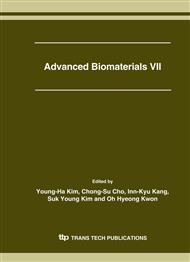p.677
p.681
p.685
p.689
p.693
p.697
p.701
p.705
p.709
Mechanism Study of Calcium Phosphate Deposition on Titanium Surface in Simulated Body Fluid
Abstract:
Previously, various surface treatments have been used to enhance the ability of titanium surfaces to induce calcium phosphate (Ca-P) formation in simulated body fluid (SBF). However, there were no systematic investigations on the key factors of the surface treatments to control such ability. In this work, three factors are studied for their roles in controlling Ca-P precipitation in SBF: surface roughness, surface chemistry and surface energy. Four kinds of single-step chemical treatments on Ti surfaces were carried out, including alkali treatment (AT), nitric acid treatment (NT), hydrogen peroxide treatment (HPT), and heat treatment. The experimental results show that the surface energy is the most likely controlling factor of Ca-P formation ability.
Info:
Periodical:
Pages:
693-696
Citation:
Online since:
July 2007
Authors:
Price:
Сopyright:
© 2007 Trans Tech Publications Ltd. All Rights Reserved
Share:
Citation:


